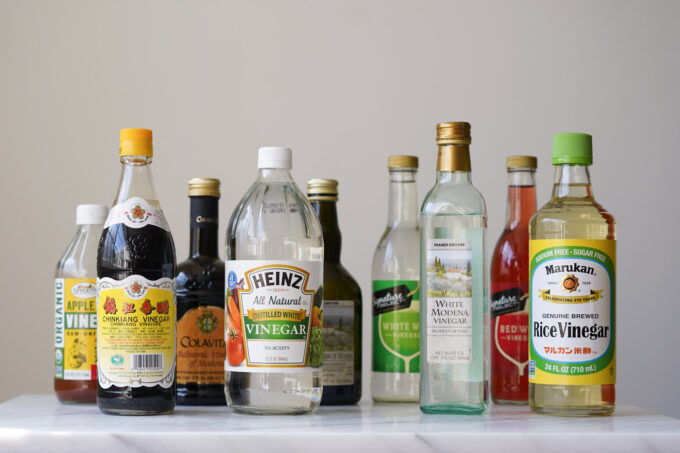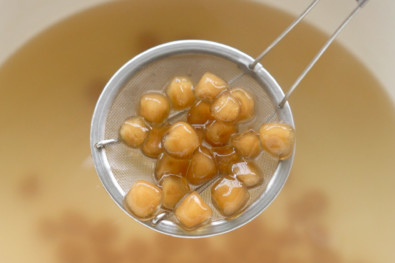
What is vinegar?
Many of us are familiar with vinegar and its status as a fundamental ingredient in the kitchen, but have you ever questioned what exactly it is? Quite simply, the term “vinegar” is from the French term “vin aigre,” which means sour wine. Vinegar is made when you take a food source with sugar (think grapes, honey, or apples) and use yeast fermentation to turn the sugar into ethanol. Then, acetic acid bacteria (Acetobactor) is used to change the ethanol into acetic acid, which makes up four to 10% of the vinegar and gives it its distinguishing potent flavor. It’s important to note that acetic acid is NOT vinegar.
Distilled white vinegar
White vinegar is one of the most commonly used types of vinegar because of its flavor, high acidity, and multitasking abilities. You can not only use it for brining chicken or pickling cucumbers and other veggies, but it can also be used as a household cleaner.
While distilled white vinegar is very accessible and can be found in many US grocery stores for an affordable price, there are also other variants of vinegar that taste different and can be harder to find. In these situations, I searched online to find the appropriate substitutions and am happy to find that some of these include white vinegar or other accessible ingredients. Please note that these substitutions are also dependent on the type of recipe you will be making. Feel free to adjust to taste depending on your recipe and preference.
Apple cider vinegar substitute
Apple cider vinegar is made by fermenting apples and has a sour taste compared to the crisp flavor of white vinegar. Apple cider vinegar has hit the health craze in recent years for possible health benefits like losing weight or lowering blood sugars, however, it’s important to note that you should always consult with your doctor before taking forms of health advice online. In the kitchen, apple cider vinegar can be used in salad dressing, brining chicken, and more.
How to make it: use a one to one ratio of apple cider vinegar to lemon or lime juice. The acidity and sour flavor is still available in both lemon and lime juice. Or you also have the option of a one to one ratio for white vinegar as well since the acidity levels are the same, to add some flavor I prefer adding a splash of lemon too.
Balsamic vinegar substitute
Balsamic vinegar is made of fermented grapes and aged to reach its concentrated, sweet and dark flavor. Originally Modena, Italy, this type of vinegar is just as popular as white vinegar. There are various recipes that include this low acidity vinegar, like roasted brussels sprouts to crispy tofu dipping sauces.
How to make it: use one tablespoon of apple cider vinegar or red wine vinegar and 1/2 teaspoon sugar for every one tablespoon of balsamic vinegar.
White wine vinegar substitute
White wine vinegar is made by fermenting white wine and has a less acidic and fruitier flavor than most vinegars. You can use white wine vinegar for salad vinaigrettes, braising meats, and fish dishes because of its bright and delicate tasting notes.
How to make it: If you happen to be out of white wine vinegar, you can substitute this with a one to one ratio of white white vinegar to rice wine vinegar.
Rice wine vinegar substitute
Rice wine vinegar or rice vinegar is made from fermented rice wine and is very popular in Asian dishes for its mild flavor and acidity. It’s sweet taste is best for sushi rice, light marinades, and light pickling.
How to make it: To substitute one tablespoon of rice wine vinegar, add one tablespoon of white wine with ¼ teaspoon of sugar. This will give you a slight acidity with a similar sweet flavor.
Red wine vinegar substitute
Red wine vinegar is also fermented from red wine and has a much stronger flavor than its white wine counterpart. Its bold flavor pairs well with vinaigrettes, sauces, and marinades for red meat like pork chops and steak.
How to make it: To substitute red wine vinegar, you can use equal parts white vinegar and red wine to get a similar flavor and acidity.
Chianking vinegar
Chianking vinegar is a rice vinegar that is known for its distinct black color and pungent taste, which sets it aside from its rice wine vinegar cousin. This is very popular to use in many Chinese recipes like dipping sauces for dumplings or beef broccoli.
How to make it: for every five tablespoons needed of chianking vinegar, combine one tablespoon of red wine vinegar and one tablespoon of balsamic vinegar.
Malt vinegar
Malt vinegar is one of the least acidic varieties of vinegar and also has a sweet tone to its flavor, which makes it great for fish and chips!
How to make it: use a one to one ratio to substitute malt vinegar for apple cider vinegar.
Champagne vinegar
Champagne vinegar has a very mild flavor and is perfect for vinaigrettes or light sauces. It’s very mild and floral flavor comes from the fermented Chardonnay or pinot noir grapes.
How to make it: use a one to one ratio of rice wine vinegar or white wine vinegar to substitute champagne vinegar.
Sherry vinegar
Sherry vinegar is a wine vinegar made historically from Spain and from its namesake, Sherry wine. It’s rich and nutty flavor is similar to its red wine and white wine cousins, however, it is not as acidic. This type of vinegar is typically used in stews, soups, and dressings.
How to make it: use a one to one ratio of apple cider vinegar to substitute sherry vinegar.









